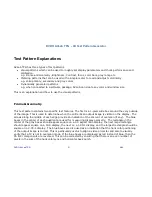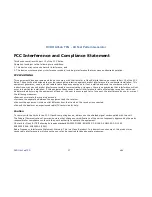
DVDO AVLab TPG - 4K Test Pattern Generator
DVDO AVLab TPG
31
A.04
a.
Checking equipment capability and the room: Contrast ratios interframe vs intraframe – Using
the large checkerboard, verify that target contrast ratios can be achieved given the room
conditions. 150:1 is always a good intraframe target.
b.
Setting up a PC (Media center or Gaming) – set up component 16-238 super white, RGB or
component, 4:2:0, aspect ratio, and output format,
c.
Playstation setup tips – cnet.com.
d.
Be sure to wear appropriate attire – no white – even stripes, no laptop pointing at screen
e.
Regarding projectors, most of the time the lamp is not a pure white but tends to put out more
blue and green than red or vice versa. In this case, to calibrate requires cutting colors as
opposed to boosting them so overall light comes down. So it depends on the usage model
whether this is better for the customer or not. A projector in a school showing only powerpoint
might be better served uncalibrated so you get more light output for the money.
f.
About meters. Basic calibration can be done with just about any meter, but some are better in
accuracy than others. Some midrange meters have pre-programmed memories that let you
choose the sink type (LCD, LED, projector front with HPD lamp etc) – these settings can make
a middle level meter work much better by ignoring some colors that are not in the color space
of the device being measured. Spectral devices (like I1pro2 and Minolta) are slower and the
ipro is good at lighter areas but poor on dark areas. To get the speed of a tri-stimulus device,
you can take a profile reading using the ipro and then apply that offset to a tri-stimulus like
the Klein or X-Rite C6 meter. C6 uses gel filters and can go out of calibration after a period of
time so recalibrate the meter periodically. However, it can only be calibrated as long as the
filters are still within a reasonable range. The Ipro has no filter and is accurate long term.
2)
Calibration Setup
a.
We recommend the ISF calibration workflow
b.
Adjust frame and geometry and make sure that overscan settings are not on by default; make
sure that the single pixel line around the edge is visible.
c.
Insure that the proper video setting is being used on the TV – it should be set to Video or YUV.
Unless you have a source that only puts out RGB, its best to have the entire system send the
display YUV and let the TV convert to RGB for display.
d.
Properly set up the test pattern generator – it needs to match the source. For instance, the
TPG should not be allowed, in normal calibration, to automatically match the TV capability.
Check the main source – blueray to other - and set TPG to that bit depth and calibrate to that.
Summary of Contents for AVLab TPG
Page 26: ...DVDO AVLab TPG 4K Test Pattern Generator DVDO AVLab TPG 26 A 04...
Page 58: ...DVDO AVLab TPG 4K Test Pattern Generator DVDO AVLab TPG 58 A 04 Then Startup Settings...
Page 61: ...DVDO AVLab TPG 4K Test Pattern Generator DVDO AVLab TPG 61 A 04...
Page 70: ...DVDO AVLab TPG 4K Test Pattern Generator DVDO AVLab TPG 70 A 04...






























